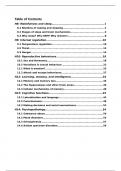Table of Contents
H8: Wakefulness and sleep........................................................1
8.1 Rhythms of waking and sleeping.................................................1
8.2 Stages of sleep and brain mechanisms........................................3
8.3 Why sleep? Why REM? Why dreams?...........................................8
H9: Internal regulation............................................................10
9.1 Temperature regulation............................................................10
9.2 Thirst......................................................................................12
9.3 Hunger....................................................................................14
H10: Reproductive behaviours.................................................18
10.1 Sex and Hormones.................................................................18
10.2 Variations in sexual behaviour................................................22
11.1 What is emotion?...................................................................25
11.2 Attack and escape behaviours.................................................27
H12: Learning, memory, and intelligence..................................34
12.1 Memory and memory loss.......................................................34
12.2 The hippocampus and other brain areas..................................36
12.3 Cellular mechanisms of memory..............................................40
H13: Cognitive functions.........................................................43
13.1 Lateralization and language....................................................43
13.2 Consciousness........................................................................49
13.3 Making decisions and social neuroscience...............................52
H14: Psychopathology.............................................................54
14.1 Substance abuse....................................................................54
14.2 Mood disorders......................................................................55
14.3 Schizophrenia........................................................................57
14.4 Autism spectrum disorders.....................................................59
,H8: Wakefulness and sleep
8.1 Rhythms of waking and sleeping
Endogenous rhythms
Endogenous circannual rhythm: internal clock that tells around what time of
year it is.
Endogenous circadian rhythm: internal clock that tells you around what time
of day it is.
- If you pull an all-nighter, you will feel more and more sleepy, until morning
arrives. Then you will feel more alert.
- Our circadian rhythm is slightly longer than 24 hours. Even in total
darkness and artificial light, the rhythm does not alter.
Setting and resetting the biological clock
Zeitgeber: stimulus that resets your circadian rhythm. Light is by far the
dominant zeitgeber for land animals, whereas the tides are important for some
marine animals. Other zeitgebers include exercise, meals, and temperature of
the environment.
- In Germany, sunrise occurs at the eastern end of Germany about half an
hour earlier than at the western end. When adults were asked about
preferred awakening and going to sleep time, it was found that people at
the Eastern edge have a sleep midpoint about thirty minutes earlier than
those at the west edge.
Jet lag: a disruption of circadian rhythms after crossing time zones.
- Phase-delay: staying awake later and awakening later (this happens going
west)
- Phase-advance: going to bed and awakening earlier (this happens going
east). Most people find it more difficult to go to sleep before their usual
time than staying up later.
- One study examined flight attendants who had spent the previous 5 years
making flights across seven or more time zones. On average, these flight
attendants had smaller than average volumes of the hippocampus and
surrounding structures and showed memory impairments.
Night-shift workers find it difficult to adjust to the schedule, even if they’ve had
these shifts for years. People adjust better if they sleep in a very dark room
during the day and work under very bright lights at night.
Circadian rhythms vary among individuals (‘morning people’ vs. ‘night owls’).
- In low-tech societies, people go to sleep about three hours after sunset,
and wake up at sunrise. In high-tech societies, people stay awake later
and get less sleep.
- Teenagers tend to stay up later than adults in every studied culture across
the world. This can lead to problems at school. Teenagers experience an
almost continuous ‘jet lag’. Especially evening types tend to get lower
than average test scores, especially in the morning classes.
Mechanisms of the biological clock
Suprachiasmatic nucleus (SCN): a part of the hypothalamus and the main
driver of rhythms for sleep and body temperature.
- The SCN generates circadian rhythms automatically. If SCN neurons are
disconnected from the rest of the brain and maintained in tissue culture,
they continue to produce a circadian rhythm. A single SCN cell can
1
, maintain a circadian rhythm, but multiple neurons sharpen the accuracy of
the rhythm.
- There are certain retinal ganglion cells that have their own photopigment
(melanopsin). These special ganglion cells receive some input from rods
and cones. They respond slowly when light comes on and decline slowly
when the light ceases. These ganglion cells respond mainly to short-wave
(blue) light, which can delay the circadian rhythm.
2
, Two genes produce a circadian rhythm. Period (produces protein PER) and
timeless (produces protein TIM).
1. Early in the morning, RNA levels responsible for producing PER and TIM
start at low concentration.
2. As the day furthers, they increase synthesis of the proteins. As the PER
and TIM protein concentrations increase, they feed back to inhibit the
genes that produce the RNA molecules.
3. During the night, PER and TIM concentrations are high, and decline
throughout the night.
Light activates a chemical that breaks down the TIM protein about as fast as it
forms, keeping the fly awake.
Melatonin: a chemical found in nearly all animals (except sponges), which helps
regulate sleep and wakefulness, the onset of puberty and adjustments to
changes of season.
- Melatonin secretion starts to increase two to three hours before bedtime.
Pineal gland: an endocrine gland located just posterior to the thalamus, which
releases melatonin.
8.2 Stages of sleep and brain mechanisms
Sleep and other interruptions of consciousness
Coma: an extended period of unconsciousness caused by head trauma, stroke,
or disease. Low level of brain activity and no response to (painful) stimuli. Most
people in a coma either die or begin to recover within a few weeks.
Unresponsive wakefulness syndrome: alternates between sleep and arousal.
Even during the aroused stage, the person has no awareness of surroundings
and no purposeful behaviour. Breathing is more regular and pain stimuli increase
heart rate, breathing, and sweating.
Minimally conscious state: brief periods of purposeful actions and a limited
amount of speech comprehension. This stage can last for months or years.
Brain death: condition with no sign of brain activity and no response to any
stimulus. After 24 hours of no brain activity, physicians pronounce someone
brain dead.
Stages of sleep
Polysomnograph: combination of EEG and eye-movement records.
Alpha waves: 8-12 waves a second: sleep has just begun.
3




